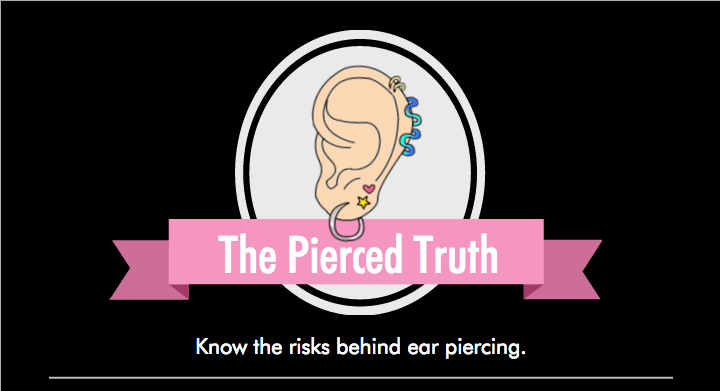June* looked in the mirror, staring at the holes in her earlobes that were now basically closed because of infection. As she tried to push her diamond-studded earring back into the hole, the only result was pus and blood.
According to students who answered a Chronicle poll, almost one out of six have had some sort of infection as a result of their piercings. Of the 42 percent of students that have had some sort of ear piercing, 14.1 percent have experienced complications.
Ear piercing infections can occur for several reasons — unsterilized equipment, improper care, such as touching the hole with unsanitized hands, tight earrings that block blood flow to the ears and rough surfaces on certain earrings.
There is a risk of transmitting infections, HPV and hepatitis if the piercer does not use properly sterilized instruments, according to an article published in the Journal of the American Medical Association on Feb. 25, 2014.
While her ear bled, June had to keep her bathroom door shut. June could never tell her parents who didn’t know that June had gotten an ear piercing in the first place.
In California, the law states that anyone under 18 can get a piercing only with the presence or consent of a parent.
However, June’s friend had informed her about a jewelry store in a small mall in Koreatown that would pierce ears without any parent’s consent. The following day, June was on her way to get her first lobe piercing.
In order to hide her piercings from her parents, June constantly had her hair down, covering her ears.
“Whenever I went back home, I’d take out my earrings, which made my ears infected and closed in the end,” June said.
Nikta Mansouri’s ’15 grandfather didn’t allow her mother to get any piercings until she was an adult, which her mother uses as a rule for her, as well, but with an exception. The policy was that Mansouri could get lobe piercings but nothing else until she was an adult.
“My mom says that I can do whatever I want with my body — like tattoos or piercings — but [only] when I am financially responsible [for] myself,” Mansouri said.
“Even though I was jealous of my friends who had just gotten cartilage piercings in 10th grade, I don’t really feel the need to get piercings now that I’m a senior,” Mansouri said. “It’s just a fashion trend that comes and goes.”
Students who’ve gotten permission from their parents have the option to go to a tattoo parlor or a pediatrician to get their earlobes pierced. After trying the former, Erica Jaffe ’16 experienced an ear infection on her left earlobe after two weeks of cleaning her ears daily and nightly. The next month, Jaffe, determined to get her left ear re-pierced, went to Dr. Monica Asnani’s Santa Monica office to get a “medically-safe” ear piercing.
“It was the best decision in the end because my ears haven’t been infected since,” Jaffe said. “It’s also just reassuring to know that a doctor — who certainly knows what she’s doing — will be taking care of you and not just some random girl in her 20s” who may have only a few weeks’ experience piercing.
One of the most popular, legal places to get ears pierced is the retail store Claire’s. On Claire’s Ear Piercing website, the store said it had performed more than 90 million piercing operations on ears over the past 30 years at more than 3,000 stores, domestic and international.
After her infection, June stopped fidgeting with her ears and let her holes fully close but intends to pierce her ears again. She thinks that she has no choice but to return to the illegal piercing parlor in Koreatown where she got her ears pierced for the first time.
“Once the summer ends, I’ll sweat less, and there will be less of a chance that I’ll get an infection,” June said. “I’ll re-pierce my ear lobes again and maybe even get my cartilages pierced.”
*Names have been changed.




























